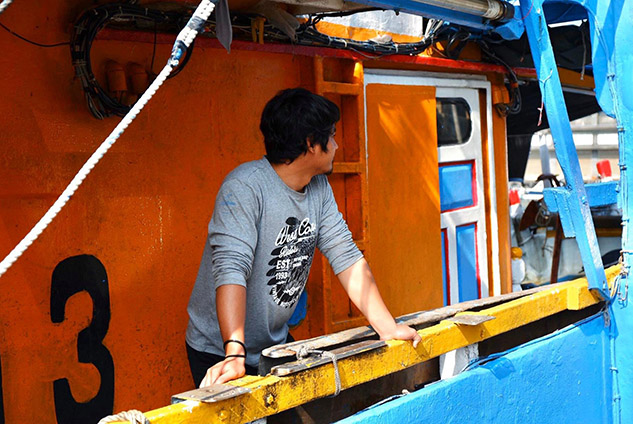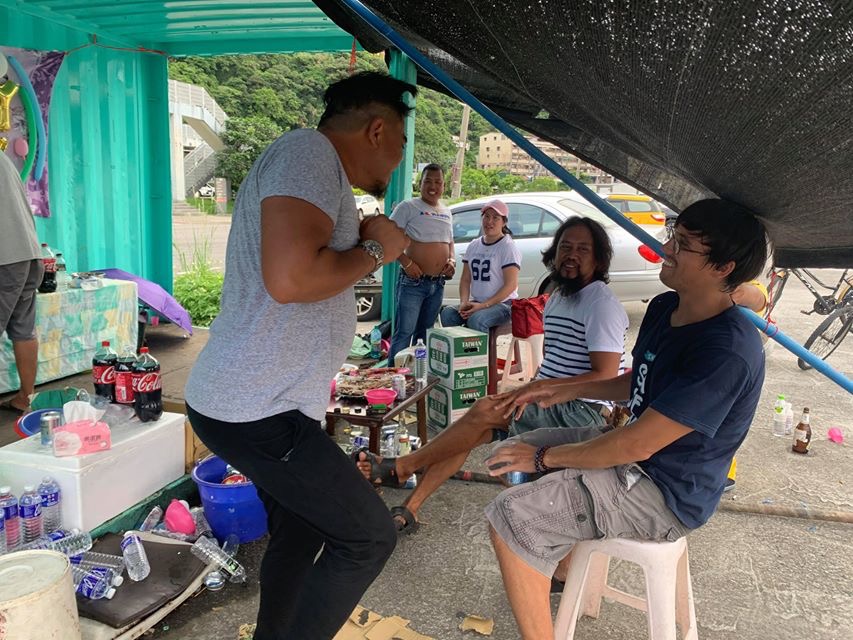The Rootless: Migrant Labor through the Eyes of the Oppressed

Source:Andi Kao
The Rootless has been one of the most accurate depictions of blue-collar Southeast Asian labor migration in film or television in recent years. From the position of the oppressed, the “problem” is not so much migrant labor as the power of capital and chauvinism of organized labor, but organized labor chooses to defend narrow, short-term economic benefits at the expense of the long-term degradation of labor as a whole.
Views
The Rootless: Migrant Labor through the Eyes of the Oppressed
By Andi Kaoweb only
“Little friend,” a man in a pressed plaid shirt clasps his hands together, leaning forward to address a 6-year old boy seated across the table. “Do you think you are Taiwanese?”
At first glance, the scene could easily be mistaken for a trip to the principal’s office. But the matter at hand is more serious than a schoolyard squabble. Zi Han (子涵) is the son born out of wedlock of Xiao Lan (小蘭), a Taiwanese woman, and Lê Văn Thành, known as Li Wen Cheng (黎文誠), a Vietnamese man who leaves his wife and children in Vietnam to work as a migrant fisher in Taiwan. The man addressing Zi Han is a government functionary. Zi Han’s father has been deported and his mother has moved to Uruguay, leaving him in the care of Nan Ge (南哥), his father’s former employer, without official documentation. The government official has the unenviable task of denying legal status to young Zi Han.
The scene closes the middle segment of The Rootless (無主之子), a 3-part television drama produced by Huang Chih-hsiang (黃志翔). The Rootless explores the hardships faced by Southeast Asian migrants from their perspective, or, more precisely, from the perspective of the oppressed. At the premiere of the drama, Huang noted how the production team took great care in navigating the politics of positionality.
“We wanted to shoot about the topic of migrant workers and also undocumented migrant workers, the so-called vulnerable groups. So we thought heavily about whether our work will create any exploitation of them, just like the moral challenges faced by documentary makers during the shooting process," he said.
The Rootless has been heralded by representatives of the Taiwan International Workers’ Association (TIWA) as one of the most accurate depictions of blue-collar Southeast Asian labor migration in film or television in recent years.
The drama opens with 25-year-old Lê Văn Thành (黎文誠) arriving in Taiwan in 2001. Over the course of the first segment, we follow Lê as he navigates the social milieu of a small community in southern Taiwan, befriending A Hai (阿海), one of two fellow Vietnamese crew members, becoming intimate with Xiao Lan through mutual care and protection, and confronting the abusive behavior of the engineer and boat owner-captain.
Many of the themes developed in The Rootless should be familiar to an audience aware of the precarious situation of blue-collar migrant workers. We witness exploitation, discrimination, criminalization, police brutality, hazardous working conditions, and vulnerability to deportation. More significant, however, are the ways in which The Rootless sheds light on truths often hidden or obscured by mainstream narratives.

Chief among these is the reality of social integration. Soon after the lifting of martial law, in the midst of a tremendous outburst of labor activism, the government opened a limited set of occupations in the low-paid, labor-intensive labor market to Southeast Asian and Chinese migrants. The government sought to prevent migrants from exercising political or social freedoms, and to therefore create an inexhaustible supply of socially excluded, right-less labor.
At the same time, the government facilitated investment in China and Southeast Asia. Foreign direct investment encouraged migration, particularly out-migration from areas where Taiwanese capital disrupted existing subsistence patterns. While the goal of both labor market and foreign investment policies was access to cheap, subjugated labor, the consequence was the remaking of social and political boundaries.
In The Rootless, for instance, Li Wen Cheng arrives in Taiwan competent in Mandarin having worked in a Taiwanese-owned factory in Vietnam. Although we do not learn any more details about the Taiwanese-owned factory, we can speculate about its social environment. One can easily imagine Li Wen Cheng hearing about the lifestyle and employment opportunities in Taiwan through his job at this factory. Perhaps the factory was responsible for transforming community practices through destructive environmental practices, as highlighted by the Formosa Ha Tinh Steel Corporation scandal in 2016, or maybe it simply threw people working at other factories into unemployment by engaging in cutthroat labor practices. In any case, Li Wen Cheng’s life had already been directly impacted by Taiwanese investment prior to first stepping foot on the island.
We witness, too, how Southeast Asian migrants shape and are shaped by social relations by their very presence. It is axiomatic that domination is never so complete as to reduce people to pure labor power. Although Xiao Lan’s relationship with Li Wen Cheng begins as a market exchange, their companionship ultimately influences her relationships with family and community members by evoking jealousy, exacerbating conflict, and encouraging resistance to patriarchy and misogyny.
Informal labor market activity is another vast realm characterized by intimate interaction between Southeast Asian migrant workers and the Taiwanese working class. In the third segment, Zi Han is now a young adult working for Nan Ge in construction. The course of events leads Zi Han to search for various forms of informal work – deep-frying chicken at a night market, collecting recyclables.
Finally, although not depicted in the drama, a real-life Li Wen Cheng would surely have counted Vietnamese “new residents” (新住民) within his social circle. Many of these “new residents” would likely have begun their journeys to Taiwan as migrant workers themselves, further belying the notion of Southeast Asian migrant labor as outsiders tightly sealed off from Taiwanese society.
As The Rootless makes clear, to treat Southeast Asian migrant workers as outsiders is to ignore social reality. Such an attitude has historically been the position of Taiwanese organized labor with disastrous consequences for working class interests. In the mid-1990s, squeezed by the threat of redundancy through a wave of factory closures and fearing replacement by cheapened labor, labor unions chose to oppose Southeast Asian labor migration and refuse to challenge the unfreedoms of the migrant labor regime. The consequence has been unchecked growth in wealth inequality and corporate power.
It is impossible to overstate the significance of speaking from the position of the oppressed for developing political clarity regarding the nature of blue-collar Southeast Asian labor migration. From this perspective, the “problem” is not so much migrant labor as the power of capital and chauvinism of organized labor. In closing ranks against migrant workers, organized labor chooses to defend narrow, short-term economic benefits at the expense of the long-term degradation of labor as a whole.

A broader social critique skillfully woven through The Rootless emerges through the extended metaphor of aliens. Xiao Lan’s father suffers from delusions of aliens as a result of pesticide poisoning. Whereas Xiao Lan’s mother and brother exhibit a deep sense of personal shame over the father’s condition, Li Wen Cheng treats the father humanely and with dignity.
This empathy is traced to Li Wen Cheng’s personal experience of war. When Li Wen Cheng learns that his Vietnamese co-worker’s son is malformed from birth, he immediately asks whether this was a result of Agent Orange left by the American forces. We get a sense that Li Wen Cheng sees illness not as an individual failing, but as an indictment of structural violence. In a powerful scene, Li Wen Cheng tells Xiao Lan’s father that his own father has seen blonde-haired and big-nosed aliens as well, flying through the sky and dropping many bombs.
The metaphor of aliens thus operates on two levels. First is the obvious one wherein Southeast Asia migrant workers are treated as aliens to Taiwanese society. The second, and more provocative reading, is of aliens as a metaphor for the brutal violations committed by Western civilization in general, and the US in the post-WWII period in particular, in Asia, Africa, and Latin America. In the last segment, Li Wen Cheng has been deported to Vietnam. He informs Zi Han, now eighteen years old, while on a video call that the bananas he is growing will be exported to Taiwan this year. Zi Han asks, “don’t you hate foreigners?” Li Wen Cheng responds with exasperation, saying that, “there’s nothing I can do, they have taken all the land from us.”
Xiao Lan has a choice to make at the end of the first segment. Lin Wen Cheng has fled from his employer, becoming an undocumented worker. Her mother has informed her that they are going to the hospital the next day to abort her unborn child. While getting ready for bed, Xiao Lan’s father tells her that the decision to leave is up to her, despite Xiao Lan having mentioned nothing to him about running away. “There will only be more and more aliens,” he says as he is lying down with eyes closed.
How should we interpret this statement? On one level, the number of Southeast Asian migrant workers, including the proportion of undocumented migrant workers, is indeed set to increase. By 2020, the number of Southeast Asian migrant workers has surpassed 700,000, with 50,000 undocumented migrant workers and an estimated 7,000 undocumented children.
On another level, it is important to note that this scene takes place in 2001, on the cusp of the US “War on Terror.” The intervening years will bring expanded and intensified US military activity throughout the globe, but particularly concentrated in the Afro-Asia region. From the perspective of people long suffering under the oppressive weight of Western civilization, this activity constitutes the greatest threat to peace and freedom.
The choice confronting Xiao Lan is a moral one, a decision of how she wishes to live her life. It is, ultimately, a question of responsibility. By choosing to leave with Li Wen Cheng, Xiao Lan has chosen unity with the oppressed, the dark proletariat. It is a choice we all must make.
Andi Kao (高燕迪) is a PhD Candidate at Cornell University and affiliate with the Global Asia Research Center (GARC) at National Taiwan University (NTU). He is currently conducting research on migrant labor and the Taiwanese fishing industry.






